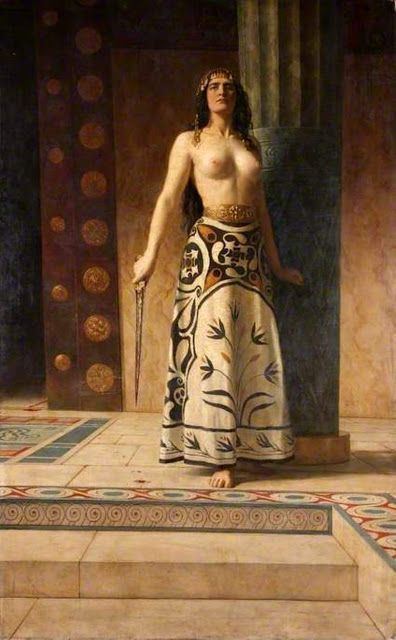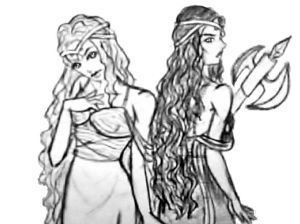Significant others Agamemnon, Aegisthus | ||
 | ||
Played by Irene Papas, Fiona Shaw, Aleka Katseli, Evelyne Didi, Eva Bianco Similar | ||
Clytemnestra (Greek: Κλυταιμνήστρα, Klytaimnḗstra, [klytai̯mnɛ̌ːstra]) was the wife of Agamemnon and queen of Mycenae (or sometimes Argos) in ancient Greek legend. In the Oresteia by Aeschylus, she murdered Agamemnon – said by Euripides to be her second husband – and the Trojan princess Cassandra, whom he had taken as war prize following the sack of Troy; however, in Homer's Odyssey, her role in Agamemnon's death is unclear and her character is significantly more subdued.
Contents

Name

Her Greek name Klytaimnḗstra is also sometimes latinized as Clytaemnestra. It is commonly glossed as "famed for her suitors". However, this form is a later misreading motivated by an erroneous etymological connection to the verb mnáomai (μνάoμαι, "woo, court"). The original name form is believed to have been Klytaimḗstra (Κλυταιμήστρα) without the -n-. The present form of the name does not appear before the middle Byzantine period. Aeschylus, in certain wordplays on her name, appears to assume an etymological link with the verb mḗdomai (μήδoμαι, "scheme, contrive").
Background

Clytemnestra was the daughter of Tyndareus and Leda, the King and Queen of Sparta. According to the myth, Zeus appeared to Leda in the form of a swan, seducing and impregnating her. Leda produced four offspring from two eggs: Castor and Clytemnestra from one egg, and Helen and Polydeuces (Pollux) from the other. Therefore, Castor and Clytemnestra were fathered by Tyndareus, whereas Helen and Polydeuces were fathered by Zeus.

Agamemnon and his brother Menelaus were in exile at the home of Tyndareus; in due time Agamemnon married Clytemnestra and Menelaus married Helen. In a late variation, Euripides's Iphigenia at Aulis, Clytemnestra's first husband was Tantalus, King of Pisa; Agamemnon kills him and his infant son, then made Clytemnestra his wife. In another version, her first husband was King of Lydia. The kings of Lydia, according to Plutarch's The Greek Questions, 45, having succeeded Omphale who had received from Herakles Hippolyte's (the queen of the Amazons') axe, carried this axe (called labrys by Lydians) as one of their sacred insignia of office. In the tradition following the Sicilian lyric poet Stesichorus's Oresteia Clytemnestra used such double-edged ax to assist her lover Aegisthos in the killing of Agamemnon (and later, to kill her son Orestes, as he arrived to avenge his father's death), as depicted on the mixing bowl (calyx krater) with the killing of Agamemnon (Early Classical Period – about 460 B.C.) by the Dokimasia Painter.
Mythology

After Helen went (or was taken) from Sparta to Troy, her husband, Menelaus, asked his brother Agamemnon for help. Greek forces gathered at Aulis. However, consistently weak winds prevented the fleet from sailing. Through a subplot involving the gods and omens, the priest Calchas said the winds would be favorable if Agamemnon sacrificed his daughter Iphigenia to the goddess Artemis. Agamemnon persuaded Clytemnestra to send Iphigenia to him, telling her he was going to marry her to Achilles. When Iphigenia arrived at Aulis, she was sacrificed, the winds turned, and the troops set sail for Troy.

The Trojan War lasted ten years. During this period of Agamemnon's long absence, Clytemnestra began a love affair with Aegisthus, her husband's cousin. Whether Clytemnestra was seduced into the affair or entered into it independently differs according to the respective author of the myth.

Nevertheless, Clytemnestra and Aegisthus began plotting Agamemnon's demise. Clytemnestra was enraged by Iphigenia's murder (and presumably the earlier murder of her first husband by Agamemnon, and her subsequent rape and forced marriage). Aegisthus saw his father Thyestes betrayed by Agamemnon's father Atreus (Aegisthus was conceived specifically to take revenge on that branch of the family).

In old versions of the story, on returning from Troy, Agamemnon is murdered by Aegisthus, the lover of his wife, Clytemnestra. In some later versions Clytemnestra helps him or does the killing herself in his own home. The best-known version is that of Aeschylus: Agammemnon, having arrived at his palace with his concubine, the Trojan princess Cassandra, in tow and being greeted by his wife, entered the palace for a banquet while Cassandra remained in the chariot. Clytemnestra waited until he was in the bath, and then entangled him in a cloth net and stabbed him. Trapped in the web, Agamemnon could neither escape nor resist his murderer.
Meanwhile, Cassandra saw a vision of herself and Agamemnon being murdered. Her attempts to elicit help failed (she had been cursed by Apollo that no one would believe her prophecies). She realized she was fated to die, and resolutely walked into the palace to receive her death.
After the murders, Aegisthus replaced Agamemnon as king and ruled for seven years with Clytemnestra as his queen. In some traditions they have three children: a son Aletes, and daughters Erigone and Helen. Clytemnestra was eventually killed by her son by Agamemnon, Orestes. The infant Helen was also killed. Aletes and Erigone grow up at Mycenae, but when Aletes comes of age, Orestes returns from Sparta, kills his half-brother, and takes the throne. Orestes and Erigone are said to have had a son, Penthilus.
